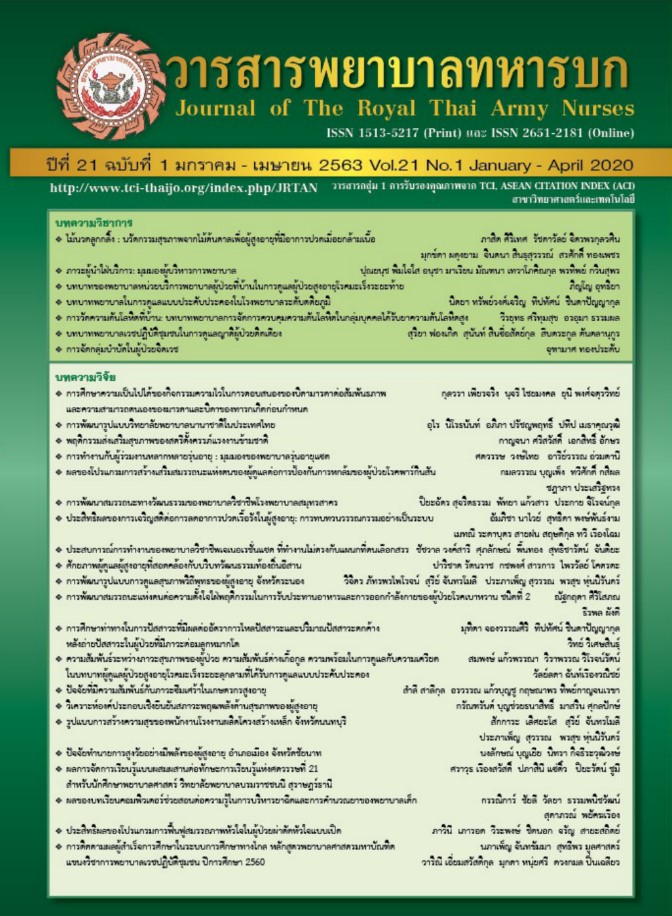Compared Position of Urination on Uroflowmetry and Post Void Residual in Patient with Benign Prostatic Hyperplasia (BPH)
Keywords:
Voiding position, Benign prostatic hyperplasia, UroflowmetryAbstract
This research aimed to compare the results of uroflowmetry parameters include maximum flow rate (Qmax), average flow rate (Qave), voided volume, voiding time and post-void residual urine (PVR) in the sitting and standing position in patients with BPH. Forty-four men with lower urinary tract symptoms (LUTS) due to BPH were enrolled in the one group pretest-posttest design study at urodynamics room in Ramathibodi hospital. The uroflowmetry were performed in both standing and sitting positions. The PVR were measured by bladder scan after each voiding. Uroflowmetry parameters and PVR values were compared between the two different voiding positions. The results showed that voided volume and voiding time were significantly increased in sitting position than the standing position. The PVR urine volume was significantly lower in the sitting position than the standing position. However, there were no significant differences between voiding positions regarding the Qmax and Qave in patients with BPH. Suggestion that the PVR seem to be affected by the voiding position (standing or sitting) in patient with BPH. Sitting position may be recommended for men with BPH to decrease PVR that may be reduce the risk of urinary tract infection.
Downloads
References
Fukuta F, Masumori N, Mori M, Tsukamoto T. Natural history of lower urinary tract symptoms in Japanese men from a 15-year longitudinal community-based study. BJU Int. 2012;110(7):1023-29.
Lim KB. Epidemiology of clinical benign prostatic hyperplasia. Asian J Urol. 2017; 4(3): 148–151.
Medical Record unit (2016-2018) Annual statistics report, Bangkok: Medical statistics unit, Medical record and statistics division, Faculty of medical, Ramathibodi hospital, Mahidol university. (in Thai)
Hollingsworth JM, Wilt TJ. Lower urinary tract symptoms in men. BMJ. 2014; 349: g4474.
de Jong Y, Pinckaers JHFM, ten Brinck RM, Lycklama a` Nijeholt AAB, Dekkers OM. Urinating standing versus sitting: Position is of influence in men with prostate enlargement. A Systematic Review and Meta-Analysis. PLoS ONE. 2014; 9(7): e101320.
El-Bahnasawy MS, Fadl FA. Uroflowmetric differences between standing and sitting positions for men used to void in the sitting position. Urology. 2008; 71(3): 465-468.
Aghamir SM, Mohseni M, Arasteh S. The effect of voiding position on uroflowmetry findings of healthy men and patients with benign prostatic hyperplasia. Urol J. 2005; 2(4): 216-221.
Choudhury S, Agarwal MM, Mandal Ak, Mavuduru R, et al. Which voiding position is associated with lowest flow in healthy adult men? role of natural voiding position. Neurourol Urodyn 2010;29:413-417.
Goel A, Kanodia G, Sokhal AK, Singh K, Agrawal M, Sankhwar S. Evaluation of Impact of Voiding Posture on Uroflowmetry Parameters in Men. World J Mens Health. 2017;35(2): 100-106.
Faul F, Erdfelder E, Lang AG, Buchner A. G*Power 3: A flexible statistical power analysis program for the social, behavioral, and biomedical sciences. Behav Res Methods. 2007;39(2):175-191.
Wiratchai N. Using statistics. 2nd editions. Bangkok: Icon printing; 2012.
Lee CL, Kuo HC. Pathophysiology of benign prostate enlargement and lower urinary tract symptoms: Current concepts. Ci Ji Yi Xue Za Zhi. 2017;29(2):79-83.
Calogero AE, Burgio G, Condorelli RA, Cannarella R, La Vignera S. Epidemiology and risk factors of lower urinary tract symptoms/benign prostatic hyperplasia and erectile dysfunction. Aging Male. 2018; 2:1-8.
Unsal A, Cimentepe E. Effect of voiding position on uroflowmetric parameters and post-void residual urine volume in patients with benign prostatic hyperplasia. Scand J Urol Nephrol. 2004;38(3):240-242.
Downloads
Published
How to Cite
Issue
Section
License
บทความหรือข้อคิดเห็นใดใดที่ปรากฏในวารสารพยาบาลทหารบกเป็นวรรณกรรมของผู้เขียน ซึ่งบรรณาธิการหรือสมาคมพยาบาลทหารบก ไม่จำเป็นต้องเห็นด้วย
บทความที่ได้รับการตีพิมพ์เป็นลิขสิทธิ์ของวารสารพยาบาลทหารบก
The ideas and opinions expressed in the Journal of The Royal Thai Army Nurses are those of the authors and not necessarily those
of the editor or Royal Thai Army Nurses Association.






